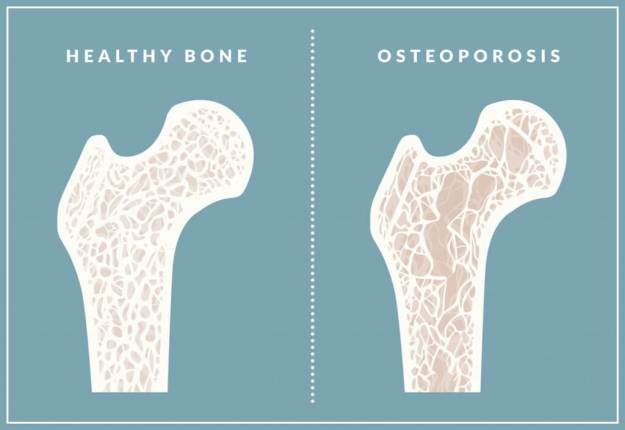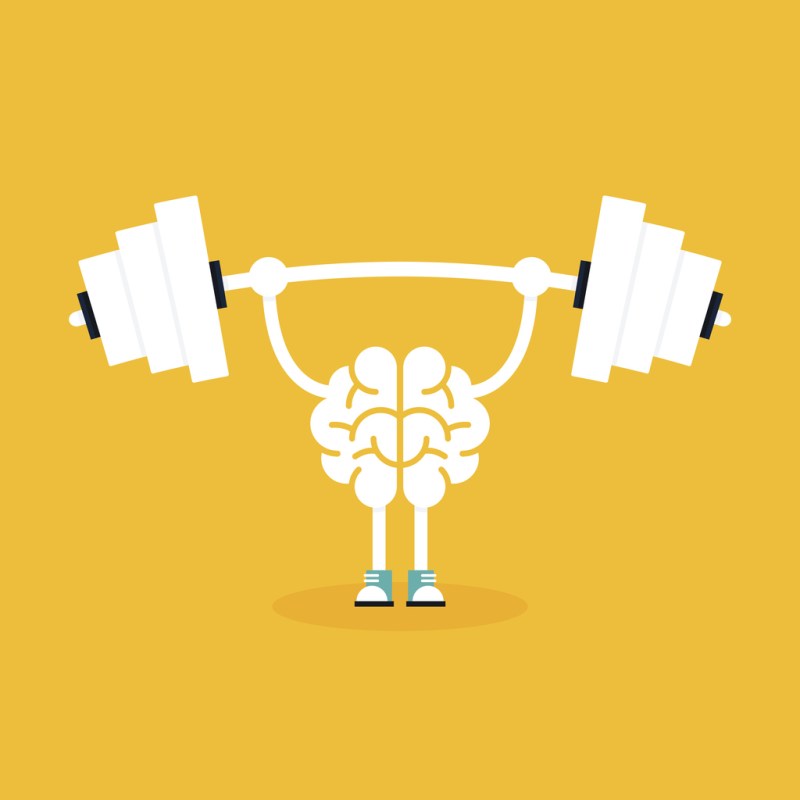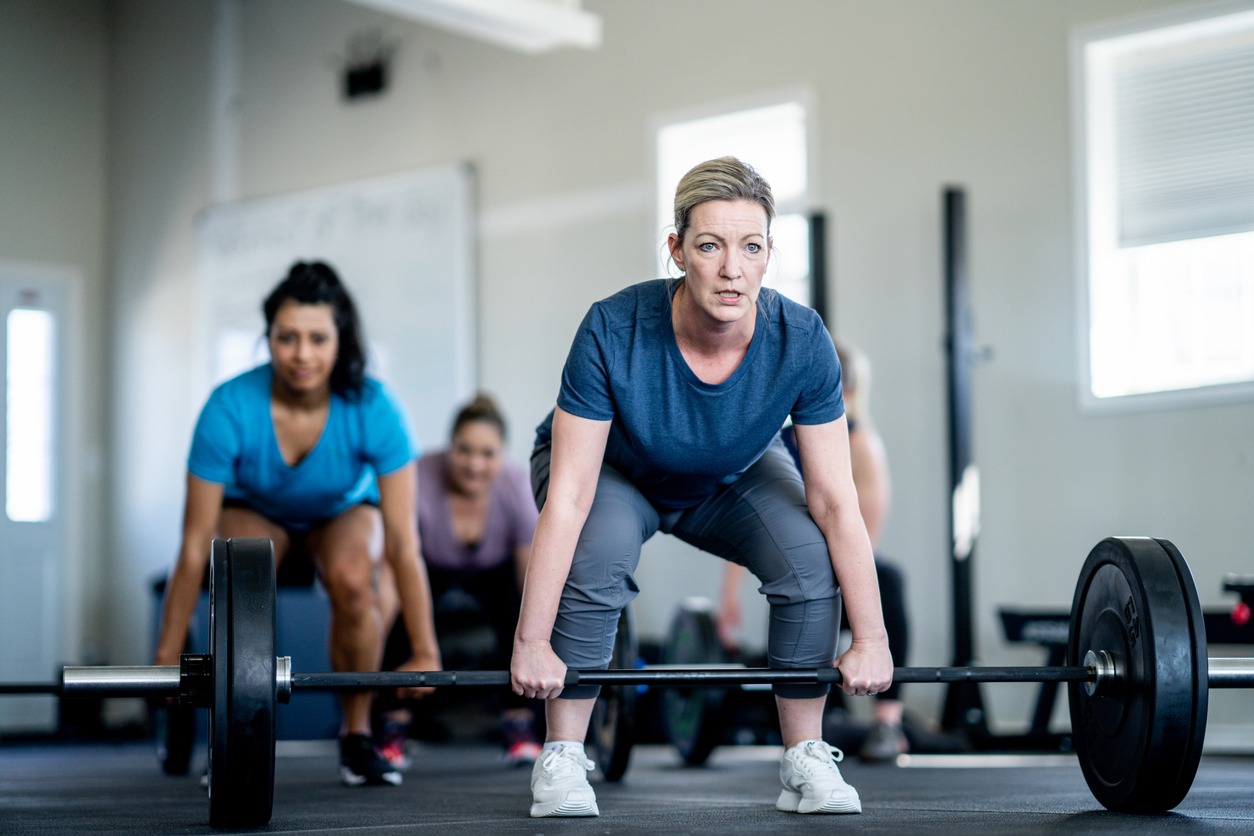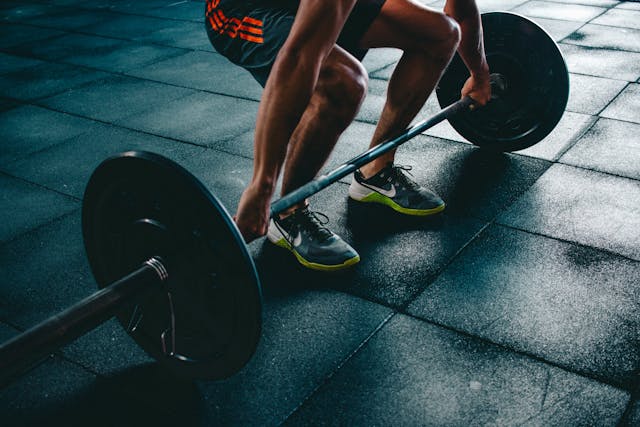Recently, I spoke with a small group of women about new activities we’ve tried lately to freshen up our lives. Two of the women excitedly told of their new venture into lifting heavy weights. I thought, “Heavy weight lifting for women? Interesting…” After all the years of being told to stay thin or being warned against getting “too muscular,” I wondered what I might be missing.
One petite woman proudly announced that she had lifted 250 pounds with her legs! Needless to say, we were all very impressed. We were even more curious when she told us she had lost a full inch around each thigh in just two months, her osteoporosis was improving, and she was losing weight. I also might add that she worked with a personal trainer. But would lifting heavy weights — as opposed to lighter ones — make that big of a difference? It turns out, it makes a huge difference.
Why It’s Important for Women To Lift Heavy Weights
Lifting heavy weights is important for women over 50 because their bodies are naturally losing muscle mass. The best way for them to save the muscle they do have and to build new lean muscle mass is to lift heavy weights that challenge them. It’s the weight that breaks down existing muscle and rebuilds it even stronger.
Strength Training for Women over 50
Women, particularly older ones, tend to back away from lifting weights that challenge them because they are afraid of building bulk. While lifting heavier weight will increase your muscle mass, it will not Hulk you out. Instead, strength training will create tone throughout your body.
Remember, many women gain weight after menopause, too. Hormone changes from menopause can affect the shape and distribution of body fat. Weight lifting tightens those areas that get loose. The more weight you lift, the more toned your body will look and feel.
Lean muscle also means more efficient calorie burning. That’s something you will need as those same hormones start to slow down your metabolism. Additional muscle helps you burn calories even when you are doing nothing but lounging on the couch.
Fight Osteoporosis with Weight Lifting 
On average, one in four women will develop osteoporosis. This condition can start as early as age 50, but it’s more common around age 65, according to the Centers for Disease Control and Prevention. As estrogen levels drop, your bones become weaker and more brittle.
Luckily, lifting weights builds bone mineral density. Why? In the 19th Century, surgeon Julius Wolff determined that bones rebuild themselves in response to heavy loads. This is one of many adaptive changes the human body makes to protect health and wellness.
For older women whose bones are weakening due to the hormonal changes that come with menopause, lifting heavier weight works to counteract bone mineral loss, reducing the risk of osteoporosis. Unfortunately, women over 50 who do not challenge their bones may show a reduction in bone density.
Protecting Your Brain Health
Did you know there’s a connection between lifting weights and preventing dementia? Researchers in Brazil recently determined that exercise in general releases irisin, a hormone capable of improving neuronal growth in the part of the brain responsible for learning and memory. The Alzheimer’s Association has even named exercise as one of the top habits you can take on to reduce the risk of dementia.
It’s not clear why some women develop diseases like Alzheimer’s, but one of the current theories associates it with faulty brain signaling. Exercise might improve that defective functioning, including critical strength training. Weight lifting for women stimulates rebuilding in the brain.
A movement like weight lifting also improves the blood flow to the brain, increasing the oxygen levels. Your brain has an amazing capacity to adjust in response to the environment and your personal health needs. Lifting just intensifies that process.
Avoid the Hunchback
Reduced muscle mass can pull the shoulders forward and round the back, creating that hunched-over look that all women fear. There is more at risk than cosmetic effects like looking hunched, though. The bad posture that can come with aging for women limits the range of motion in the shoulders, causing lower back pain and making you stiff and inflexible.
Lifting at a weight that challenges muscles gives you a stronger core and enhances the strength to support the chest, shoulder, and spinal column. In other words, it makes you less likely to hunch. It will also open up the chest and improve back alignment, so you’ll experience fewer aches.
A Strong Back Makes Everything Stronger
A toned back can compensate for weaknesses in other areas of the body, too, like the knees, hips, and shoulder joints. In a process known as kinetic chain, the body will look for weak areas and improve the muscle strength around them. There has to be muscle there to work with, though. For women over the age of 50, that muscle is less likely to be strong enough unless they lift heavy.
What About the Risks?
While there are some risks, the benefits far outweigh them. All women lifting should take precautions to enhance their safety, and that starts with talking to your medical provider before beginning any new fitness program. It’s important to get advice that is pertinent to your health challenges. For example, if you have a history of shoulder problems, the doctor might want you to do specific exercises to build strength in that joint before trying to lift heavier.
Other tips for safe lifting include:
- If you are new to weight lifting, get a trainer. There are right ways and wrong ways to lift weights. If you do it the wrong way, you are likely to get hurt. A trainer can work with you to help perfect your form and to progressively add to the weight load in a safe way.
- Plan for lifting weights to feel different. The truth is weight lifting taxes your body in ways that walking and other cardio exercises do not. It will feel different, so get ready for things to change.
- Don’t blow off rest time. As you lift, you stress the muscle tissue enough to cause damage. In response, the body tears down the tissue and rebuilds it stronger to prevent further injury. Rome was not rebuilt in a day, though. If you jump right back in the next day to work those same muscles, you are likely to lose some of the progress you’ve made by lifting. Take at least one day off a week from lifting and focus on different muscle groups each day. For example, if Monday is for arms, make Tuesday for the legs.
- Learn the difference between discomfort and pain. Feeling the burn is a real thing; it’s how you know you are challenging those muscles. Soreness a day after lifting is normal, too. Sharp pain is different. Pain is a sign of potential injury. If you feel it, stop lifting and get checked out.
Real injuries like strains or sprains can set you back weeks in your training. This is especially true for older women who may not be as active as they once were in life. That sedentary nature puts you at risk, so listen to your body to avoid serious injury.
How Much Lifting Should Older Women Do?
The American College of Sports Medicine suggests that all adults do both cardio and strength training. They recommend weight training for 20 to 30 minutes two or three days a week. Start slow and build as you lift weights to avoid overexertion that puts you at risk for injury.
Women are really just getting started at age 50. That is if they do it right. Staying active is a big part of the equation, and that should include weight lifting of some kind.
Remember: Do not start any new exercise program, particularly lifting heavy weights, before consulting with your physician.
{
“@context”: “https://schema.org”,
“@type”: “BlogPosting”,
“mainEntityOfPage”: “https://primewomen.com/health/fitness/heavy-weight-lifting-for-women-over-50/”,
“headline”: “Is Heavy Weight Lifting for Women Over 50 a Good Idea?”,
“url”: “https://primewomen.com/health/fitness/heavy-weight-lifting-for-women-over-50/”,
“inLanguage”:”en-US”,
“copyrightHolder”:”Women In Their Prime, LLC”,
“copyrightYear”:”2020″,
“wordcount”: “1281”,
“keywords”: “weightlifting for women over 50, strenth training for women, fight osteoporosis with weight lifting”,
“image”: {
“@type”: “ImageObject”,
“url”: “https://primewomen.com/wp-content/uploads/2019/05/Heavy-Dumbbells-1024×683.jpg?_t=1556759293”,
“height”: 213,
“width”: 320
},
“datePublished”: “2020-08-23”,
“dateModified”: “2021-01-19”,
“author”: {
“@type”: “Person”,
“name”: “Prime Women”
},
“publisher”: {
“@type”: “Organization”,
“name”: “Women In Their Prime, LLC”,
“alternateName”: “Prime Women”,
“logo”: {
“@type”: “ImageObject”,
“url”: “https://primewomen.com/wp-content/uploads/2018/08/logo.jpg”,
“width”: 170,
“height”: 58
}
},
“description”: “Lifting heavy is important for women over 50 because their bodies are naturally losing muscle mass.”,
“articleBody”: “I was recently at an event for the International Women’s Forum. While talking with a small group of women at the event, the conversation turned to what we were doing or tried new lately. Two of the women excitedly told of their new venture into lifting heavy weights. Weight lifting for women? Interesting. One of the women, who is petite, proudly announced that she had lifted 250 pounds with her legs! Needless to say, we were all very impressed. We were even more curious when she told us she had lost a full inch around each thigh in just two months, her osteoporosis was improving, and she was losing weight. I also might add that they were working with a personal trainer. But would lifting heavy weights opposed to not so heavy make that big of a difference, we wondered? Turns out, it makes a huge difference. Why It’s Important for Women To Lift Heavy Weights Lifting heavy is important for women over 50 because their bodies are naturally losing muscle mass. The best way for them to save the muscle they do have and to build new lean muscle mass is to lift weight limits that challenge them. It’s that weight that breaks down existing muscle and rebuilds it stronger. Strength Training for Women over 50 Women, particularly older ones, tend to back away from lifting weights that challenge them because they are afraid of building bulk. While lifting heavier weight will increase your muscle mass, it will not Hulk you out. Instead, strength training will create tone throughout your body. Remember, many women gain weight after menopause, too. Hormone changes that come with menopause affect the shape and distribution of body fat. Weight lifting tightens those areas that get loose. The more weight you lift, the toner your body will look and feel. Lean muscle also means more efficient calorie burning. That’s something you will need as those same hormones start to slow down your metabolism. Additional muscle helps you burn calories even when you are doing nothing but lounging on the couch. Fight Osteoporosis with Weight Lifting About one in four women will develop osteoporosis, a condition that can start as early as age 50 but is more common once around age 65, according to the Centers for Disease Control and Prevention. As estrogen levels drop, your bones become weaker and more brittle. Lifting builds bone mineral density. Why? In the 19th Century, surgeon Julius Wolff determined that bones rebuild themselves in response to heavy loads. This is one of many adaptive changes the human body makes to protect health and wellness. For older women whose bones are weakening due to the hormonal changes that come with menopause. Lifting heavier weight works to counteract bone mineral loss, reducing the risk of osteoporosis. Unfortunately, women over 50 who do not challenge their bones may show a reduction in bone density. Protecting Your Brain Health Did you know there’s a connection between lifting weights and preventing dementia? Researchers in Brazil recently determined that exercise in general releases irisin, a hormone able to help improve neuronal growth in the area of the brain responsible for learning and memory. It’s not clear why some women develop diseases like Alzheimer’s but one of the current theories associates it with faulty brain signaling. Exercise might improve that defective functioning including critical strength training. Weight lifting for women stimulates rebuilding in the brain. A movement like weight lifting also improves the blood flow to the brain, increasing the oxygen levels. Your brain has an amazing capacity to adjust in response to the environment and your personal health needs. Lifting just intensifies that process. Avoid the Hunchback Reduced muscle mass can pull the shoulders forward and round the back, creating that hunched-over look that all women fear. There is more at risk than looking hunched, though. The bad posture that can come with aging for women limits the range of motion in the shoulders, causing lower back pain and making you stiff and inflexible. Lifting at a weight that challenges muscles gives you a stronger core and enhances the strength to support the chest, shoulder and spinal column. In other words, makes you less likely to hunch. It will also open up the chest and improve back alignment so fewer aches. A Strong Back Makes Everything Stronger A toned back can compensate for weaknesses in other areas of the body, too, like the knees, hips and shoulder joints. In a process known as kinetic chain, the body will look for weak areas and improve the muscle strength around them. There has to be muscle there to work with, though. For women over the age of 50, that muscle is less likely to be strong enough unless they lift heavy. What About the Risks? While there are some risks, the benefits far outweigh them. All women lifting should take precautions to enhance their safety and that starts with talking to your medical provider before beginning any new fitness program. It’s important to get advice that is pertinent to your health challenges. For example, if you have a history of shoulder problems, the doctor might want you to do specific exercises to build strength in that joint before trying to lift heavier. Other tips for safe lifting include: If you are new to weight lifting, get a trainer. There are right ways and wrong ways to lift weights. If you do it the wrong way you are likely to get hurt. A trainer can work with you to help perfect your form and to progressively add to the weight load in a safe way. Plan for lifting weights to feel different. The truth is weight lifting taxes your body in ways that walking and other cardio exercises does not. It will feel different, so get ready for things to change. Don’t blow off rest time. As you lift, you stress the muscle tissue enough to cause damage. In response, the body tears down the tissue and rebuilds it stronger to prevent further injury. Rome was not rebuilt in a day, though. If you jump right back in the next day to work those same muscles, you are likely to lose some of the progress you’ve made by lifting. Take at least one day off a week from lifting and focus on different muscle groups each day. If Monday is for arms, make Tuesday for the legs. Learn the difference between discomfort and pain. Feel the burn is a real thing. It’s how you know you are challenging those muscles. Soreness a day after lifting is normal, too. Sharp pain is different. Pain is a sign of potential injury. If you feel it, stop lifting and get checked out. Real injuries like strains or sprains can set you back weeks in your training. This is especially true for older women who may not be as active as they once were in life. That sedentary nature puts you at risk, so listen to your body to avoid serious injury. How Much Lifting Should Older Women Do? The American College of Sports Medicine suggests all adults do both cardio and strength training. They recommend weight training for 20 to 30 minutes two or three days a week. Start slow and build as you lift weights to avoid overexertion that puts you at risk for injury. Women are really just getting started at age 50. That is, if they do it right. Staying active is a big part of the equation and that should include weight lifting of some kind. Remember: Do not start any new exercise program, particularly lifting heavy weights, before consulting with your physician. Ready to get fit this season? Check out all of our tips on staying fit this summer!”
}
Read Next:
A 10 Minute Workout Routine You Can Do At Home
Don’t Let Bladder Leakage Dampen Your Workout
Step-by-Step Fat-Shredding Workout
The post Is Heavy Weight Lifting for Women Over 50 a Good Idea? first appeared on Prime Women | An Online Magazine.
Publisher: Source link











